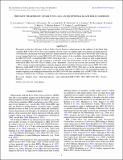| dc.contributor.author | Altamirano, D. | |
| dc.contributor.author | Belloni, Tomaso M. | |
| dc.contributor.author | Linares, Manuel Alegret | |
| dc.contributor.author | van der Klis, M. | |
| dc.contributor.author | Wijnands, R. | |
| dc.contributor.author | Curran, P. A. | |
| dc.contributor.author | Kalamkar, M. | |
| dc.contributor.author | Stiele, H. | |
| dc.contributor.author | Motta, S. | |
| dc.contributor.author | Munoz-Darias, T. | |
| dc.contributor.author | Casella, P. | |
| dc.contributor.author | Krimm, H. A. | |
| dc.date.accessioned | 2015-02-27T17:06:38Z | |
| dc.date.available | 2015-02-27T17:06:38Z | |
| dc.date.issued | 2011-12 | |
| dc.date.submitted | 2011-09 | |
| dc.identifier.issn | 2041-8205 | |
| dc.identifier.issn | 2041-8213 | |
| dc.identifier.uri | http://hdl.handle.net/1721.1/95737 | |
| dc.description.abstract | We report on the first 180 days of Rossi X-Ray Timing Explorer observations of the outburst of the black hole candidate IGR J17091-3624. This source exhibits a broad variety of complex light curve patterns including periods of strong flares alternating with quiet intervals. Similar patterns in the X-ray light curves have been seen in the (up to now) unique black hole system GRS 1915+105. In the context of the variability classes defined by Belloni et al. for GRS 1915+105, we find that IGR J17091-3624 shows the ν, ρ, α, λ, β, and μ classes as well as quiet periods which resemble the χ class, all occurring at 2-60 keV count rate levels which can be 10-50 times lower than observed in GRS 1915+105. The so-called ρ class "heartbeats" occur as fast as every few seconds and as slow as ~100 s, tracing a loop in the hardness-intensity diagram which resembles that previously seen in GRS 1915+105. However, while GRS 1915+105 traverses this loop clockwise, IGR J17091-3624 does so in the opposite sense. We briefly discuss our findings in the context of the models proposed for GRS 1915+105 and find that either all models requiring near Eddington luminosities for GRS 1915+105-like variability fail, or IGR J17091-3624 lies at a distance well in excess of 20 kpc, or it harbors one of the least massive black holes known (<3 M ☉). | en_US |
| dc.description.sponsorship | Netherlands Organization for Scientific Research (NWO Rubicon fellowship) | en_US |
| dc.description.sponsorship | European Union (European Community’s Seventh Framework Programme (FP7/2007-2013) grant agreement number ITN 215212 “Black Hole Universe”) | en_US |
| dc.description.sponsorship | Spain. Ministerio de Educación y Ciencia (Spanish MEC, Consolider-Ingenio 2010 Programme grant CSD2006- 00070: “First Science with the GTC”) | en_US |
| dc.language.iso | en_US | |
| dc.publisher | Institute of Physics/American Astronomical Society | en_US |
| dc.relation.isversionof | http://dx.doi.org/10.1088/2041-8205/742/2/l17 | en_US |
| dc.rights | Article is made available in accordance with the publisher's policy and may be subject to US copyright law. Please refer to the publisher's site for terms of use. | en_US |
| dc.source | American Astronomical Society | en_US |
| dc.title | THE FAINT “HEARTBEATS” OF IGR J17091−3624: AN EXCEPTIONAL BLACK HOLE CANDIDATE | en_US |
| dc.type | Article | en_US |
| dc.identifier.citation | Altamirano, D., T. Belloni, M. Linares, M. van der Klis, R. Wijnands, P. A. Curran, M. Kalamkar, et al. “THE FAINT ‘HEARTBEATS’ OF IGR J17091−3624: AN EXCEPTIONAL BLACK HOLE CANDIDATE.” The Astrophysical Journal 742, no. 2 (November 4, 2011): L17. © 2011 American Astronomical Society. | en_US |
| dc.contributor.department | MIT Kavli Institute for Astrophysics and Space Research | en_US |
| dc.contributor.mitauthor | Linares, Manuel Alegret | en_US |
| dc.relation.journal | Astrophysical Journal | en_US |
| dc.eprint.version | Final published version | en_US |
| dc.type.uri | http://purl.org/eprint/type/JournalArticle | en_US |
| eprint.status | http://purl.org/eprint/status/PeerReviewed | en_US |
| dspace.orderedauthors | Altamirano, D.; Belloni, T.; Linares, M.; van der Klis, M.; Wijnands, R.; Curran, P. A.; Kalamkar, M.; Stiele, H.; Motta, S.; Muñoz-Darias, T.; Casella, P.; Krimm, H. | en_US |
| dspace.mitauthor.error | true | |
| mit.license | PUBLISHER_POLICY | en_US |
| mit.metadata.status | Complete | |
